Paper Menu >>
Journal Menu >>
 Energy and Power En gi neering, 2010, 2, 262-270 doi:10.4236/epe.2010.24038 Published Online November 2010 (http://www.SciRP.org/journal/epe) Copyright © 2010 SciRes. EPE Novel Control Strategy for Multi-Level Active Power Filter without Phase-Locked-Loop Guojun Tan, Xuanqin Wu, Hao Li, Meng Liu School of Information and Electrical Engineering, China University of Mining and Technology, Xuzhou, China E-mail: gjtan@cumt.edu.cn,cumt_wuxuanqin@163.com Received June 13, 2010; revised August 9, 2010; accepted September 21 , 20 1 0 Abstract Active power filter (APF) using novel virtual line-flux-linkage oriented control strategy can not only realizes no phase-locked-loop (PLL) control, but also achieves a good inhibitory effect to interfere. However, there are some problems in the conventional method, such as the error of amplitude, the shift of phase angle and the non-determinacy of initial oriented angle. In this paper, two one-order low-pass filters are adopted in- stead of the pure integrator in the virtual line-flux-linkage observer, which can steady the phase and ampli- tude. Furthermore, an original scheme of harmonics detection under the rotating coordinate is advanced based on the simplified space vector pulse width modulation (SVPWM) strategy. Meanwhile, by using the new SVPWM algorithm, the voltage space vector diagram of the three-level inverter can be simplified and applied into that of two-level inverter, and this makes the control for Neutral Point potential easier. Keywords: Active Power Filter, Harmonics Detection, Virtual Line-Flux-Linkage Observer, Active Power Filter Control without Phase-Locked-Loop, Space Vector Pulse Width Modulation 1. Introduction The use of nonlinear loads such as power electronic de- vices leads to serious harmonics pollution and lager voltage fluctuation. Moreover, lager unbalance voltage and current distortions in the power system are harmful to the electrical equipment and power systems. Shunt active power filter (SAPF) can well compensate the har- monic whose frequency and amplitude both changes, and it is also recognized as an effective way to manage the grid harmonic, to reactive power pollution and to im- prove the quality of the power. Active power filter (APF) is a new power electronics device for dynamic harmonics restriction and reactive compensation without influenced by system inductance [1,2], besides it has such functions: adaptive ability for the parametric variation of system and load, automatic tracing and compensation for the varying harmonics [3,4]. There are some remarkable advantages in nature of three-level APF, such as lower distortion of output waveform, lower endure voltage and less switch loss, high efficiency and low electromagnetic interference (EMI), so it helps to raise the installed ca- pacity and improves the harmonics compensation effect as well as system reliability. On the one hand, the traditional harmonic current de- tection which is based on instantaneous reactive power adopts phase-lock-loop (PLL) to acquire the voltage vector angle [5-7], when the grid voltage fluctuation is more serious, PLL will be in unlocked cond ition because of the larger frequency offsets which can not accurately track the phase position. To solve th e problem, th is paper uses the virtual line-flux-linkage orientation to observe the vector angle, which converts the observation of vec- tor angle to the flux. By using the vo ltage integral on the AC side of the active filter to estimate the grid flux, PLL can be omitted; meanwhile, the power grid interference can be inhibited well. On the other hand, the traditional harmonic current detection requires that the integrated vector combined by the sine and cosine function should be synchronous and phase coincidence to the integrated vector of the three-phase positive sequence fundamental voltage, otherwise, the detection accuracy of the funda- mental positive sequence reactive component will be affected by phase difference [8]. Therefore, the harmonic detection principle based on the rotating coordinates is proposed in this paper. The application of virtual flux in active filter system also includes controlling generation of compensation cu rrent, so it has a very good control to harmonic current detection and compensation current ge- 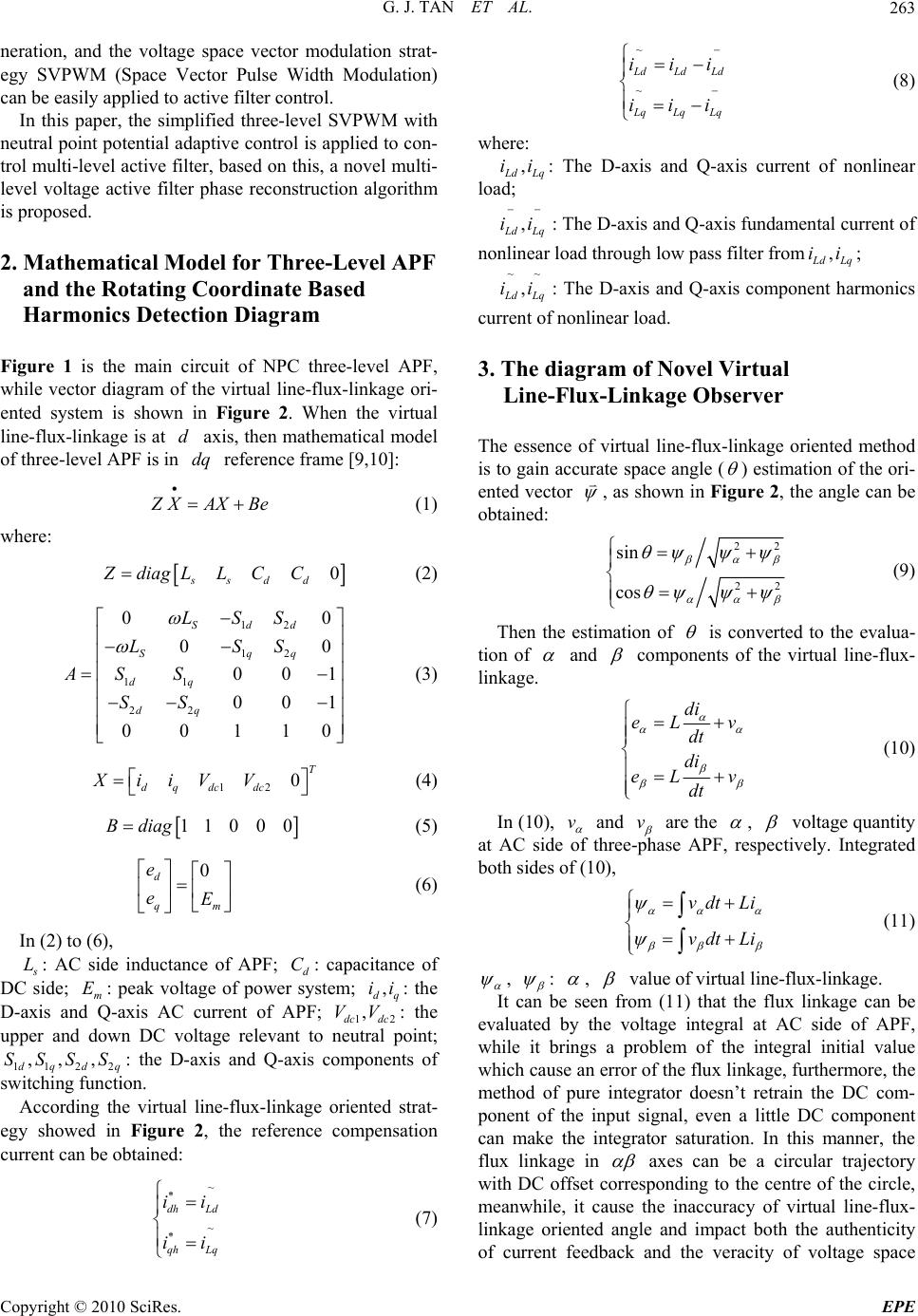 G. J. TAN ET AL.263 neration, and the voltage space vector modulation strat- egy SVPWM (Space Vector Pulse Width Modulation) can be easily applied to active filter co ntrol. In this paper, the simplified three-level SVPWM with neutral point potential ad aptive control is applied to con- trol multi-level active filter, based on this, a n ovel multi- level voltage active filter phase reconstruction algorithm is proposed. 2. Mathematical Model for Thre e -Level APF and the Rotating Coordinate Based Harmonics Detection Diagram Figure 1 is the main circuit of NPC three-level APF, while vector diagram of the virtual line-flux-linkage ori- ented system is shown in Figure 2. When the virtual line-flux-linkage is at axis, then mathematical model of three-level APF is in reference frame [9,10]: ddq Z XAXBe (1) where: 0 ssdd ZdiagL LCC (2) 12 12 11 22 00 00 001 001 00110 Sdd Sqq dq dq LSS LSS ASS SS (3) 12 0T d qdcdc XiiVV (4) 11000Bdiag (5) 0 d qm e eE (6) In (2) to (6), s L SS : AC side inductance of APF; d: capacitance of DC side; m: peak voltage of power system; : the D-axis and Q-axis AC current of APF; 12dc dc VV: the upper and down DC voltage relevant to neutral point; 112 2dqdq : the D-axis and Q-axis components of switching fu nction. C E ,S , dq ii , ,, S According the virtual line-flux-linkage oriented strat- egy showed in Figure 2, the reference compensation current ca n b e obtained: ~ * ~ * dh Ld qh Lq ii ii (7) ~ ~ L dLdLd L qLqLq iii iii (8) where: , L dLq ii: The D-axis and Q-axis current of nonlinear load; , L dLq ii : The D-axis and Q- axis funda mental current o f nonlinear load through low pass filter from, L dLq ii; ~~ , L dLq ii: The D-axis and Q-axis component harmonics current of nonl ine ar load. 3. The diagram of Novel Virtual Line-Flux-Linkage Observer The essence of virtual line-flux-linkage oriented method is to gain accurate space angle ( ) estimation of the ori- ented vector , as shown in Figure 2, the angle can be obtained: 22 22 sin cos (9) Then the estimation of is converted to the evalua- tion of and components of the virtual line-flux- linkage. di eL v dt di eL v dt (10) In (10), v and v are the , voltage quantity at AC side of three-phase APF, respectively. Integrated both sides of (10), vdt Li vdt Li (11) , : , value of virtual line-flux-linkage. It can be seen from (11) that the flux linkage can be evaluated by the voltage integral at AC side of APF, while it brings a problem of the integral initial value which cause an error of the flux linkage, furthermore, the method of pure integrator doesn’t retrain the DC com- ponent of the input signal, even a little DC component can make the integrator saturation. In this manner, the flux linkage in axes can be a circular trajectory with DC offset corresponding to the centre of the circle, meanwhile, it cause the inaccuracy of virtual line-flux- linkage oriented angle and impact both the authenticity of current feedback and the veracity of voltage space Copyright © 2010 SciRes. EPE 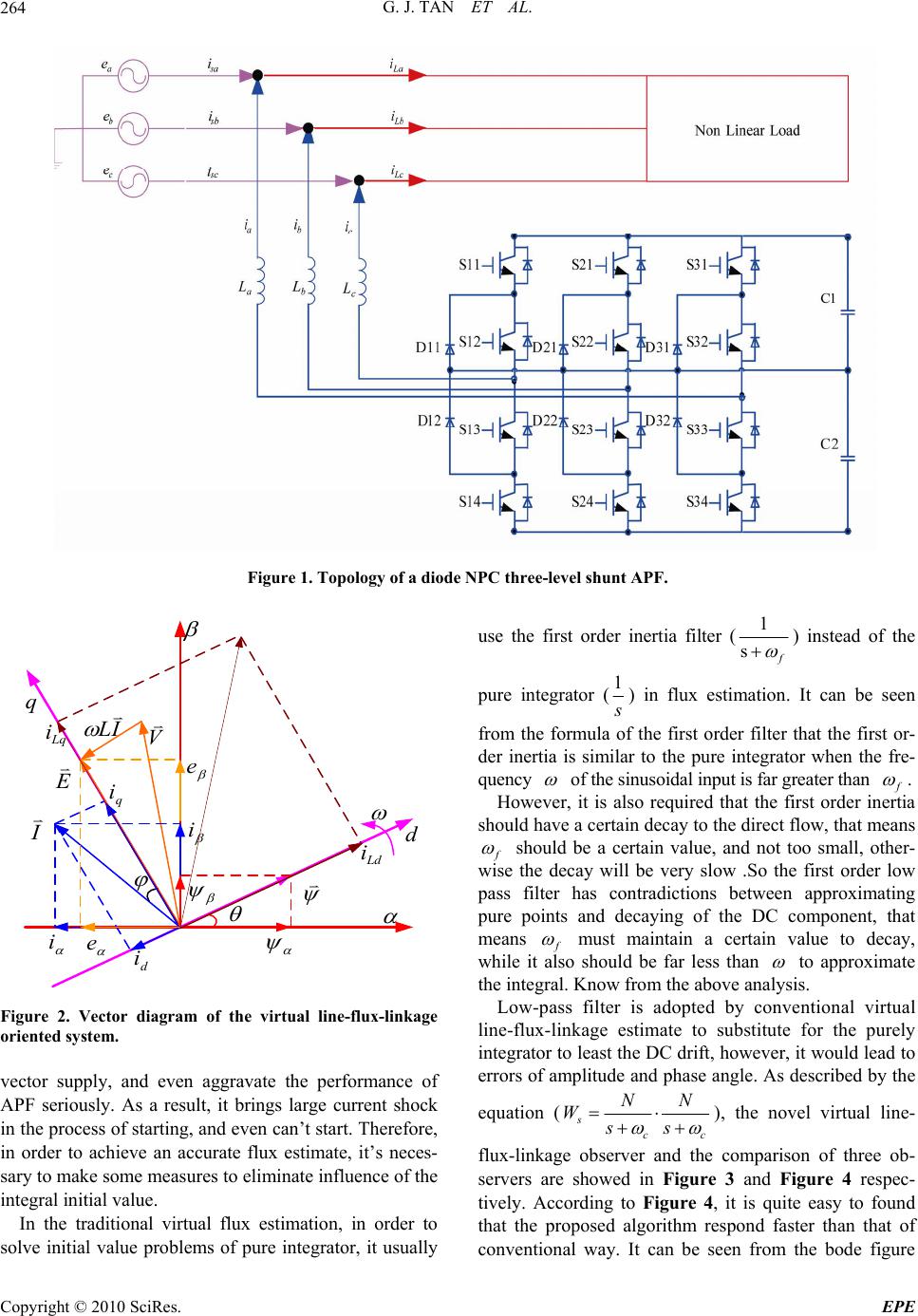 G. J. TAN ET AL. Copyright © 2010 SciRes. EPE 264 Figure 1. Topology of a diode NPC three-level shunt APF. 1 s d q e i e i E V I IL q i d i Ld i Lq i Figure 2. Vector diagram of the virtual line-flux-linkage oriented system. nd even aggravate the performance of PF seriously. As a result, it brings large current shock blems of pure integrator, it usually ter (use the first order inertia fil) instead of the f pure integrator ( vector supply, a A in the process of starting, and even can’t start. Therefore, in order to achieve an accurate flux estimate, it’s neces- sary to make some measures to eliminate influence of the integral initial value. In the traditional virtual flux estimation, in order to solve initial value pro 1) in flux estimation. It can be seen s from the formula of the first orderthat the first or- filter der inertia is similar to the pure integrator when the fre- quency of theinusoidal input is far greate r than s f . Howevr, it is also required that the first order ia enerti should have a certain decay to the direct flow, that means f should be a certain value, and not too small, other- wise theecay will be very slow .So the first order low d pa mea ss filter has contradictions between approximating pure points and decaying of the DC component, that ns f must maintain a certain value to decay, while it also should be far less than to approximate the integral. Know from the above analysis. Low-pass filter is adopted by conventional virtual line-flunkage estimate to substitute for the purely integrator to least th e DC drift, howev, it would lead to errors of amplitude and phase angle. As desc x-li er ribed by the equation (scc NN Wss ), the novel virtual line- flux-linkage observer and the comparison of three ob- servers are showed in Figure 3 and Figure 4 respec- tively. Acc, it is quite easy to found ording to Figure 4 that the proposed algorithm respond faster than that of conventional way. It can be seen from the bode figure 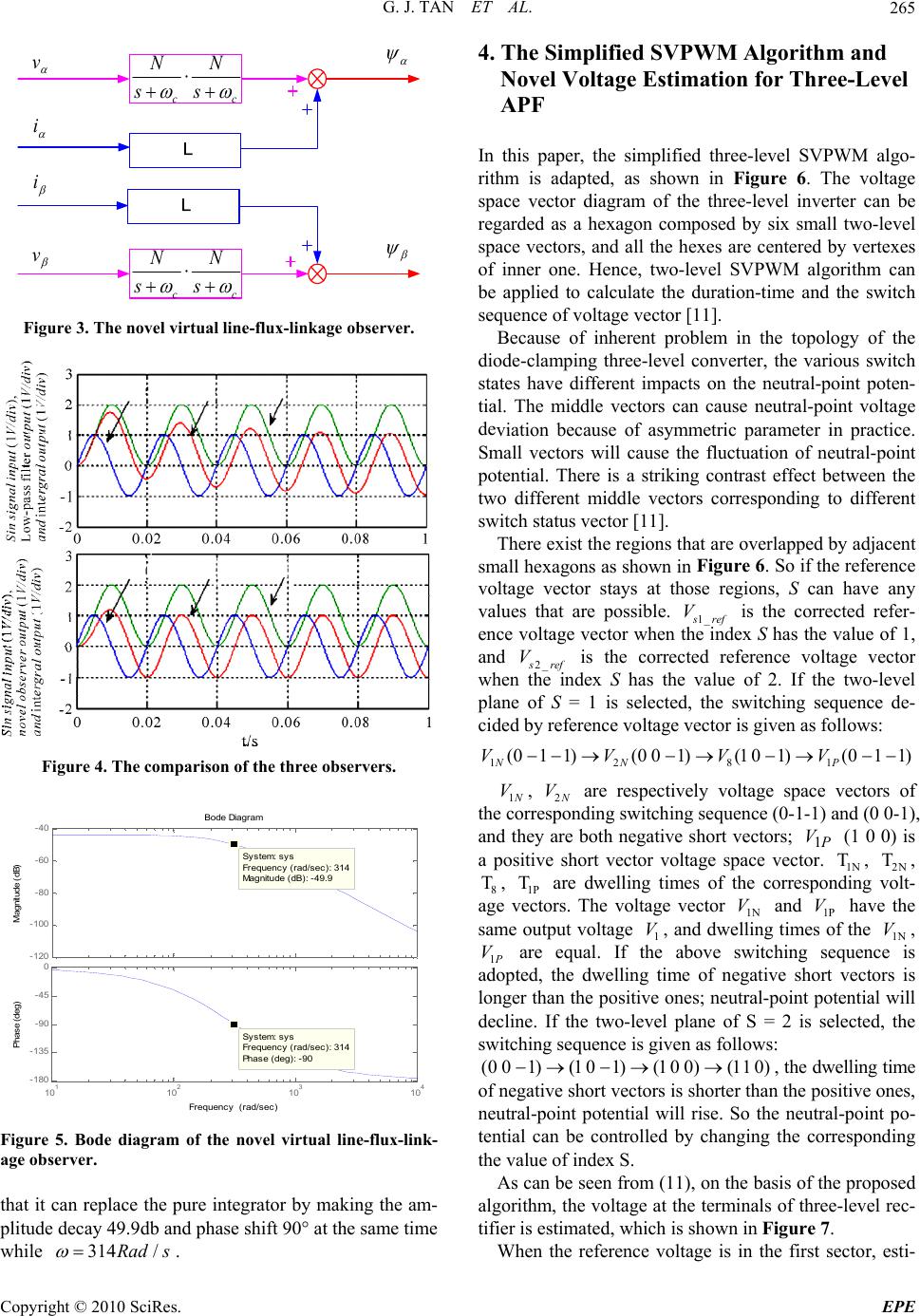 G. J. TAN ET AL.265 v i v i cc s N s N cc s N s N Figure 3. The novel virtual line-flux-linkage observer. Figure 4. The comparison of the three observers. Bode D i agram F requency (rad/sec) 101102103104 -180 -135 -90 -45 0 System: sys F requency (rad/sec): 314 Phase (deg): -90 Phase (deg) -120 -100 -80 -60 -40 System: sys F requency (rad/sec): 314 Magn itude (dB): -49.9 Magnitude (dB) Figure 5. Bode diagram of the novel virtual line-flux-link- age observer. that it can replace the pure integrator by making the am- plitude decay 49.9db and phase shift 90° at the same time while 314/Rad s . 4. The Simplified SVPWM Algorithm and rit sp tor diagram of the three-level inverter can be garded as a hexagon composed by six small two-level se neutral-point voltage de Novel Voltage Estimation for Three-Level APF In this paper, the simplified three-level SVPWM algo- hm is adapted, as shown in Figure 6. The voltage ace vec re space vectors, and all the hexes are centered by vertexes of inner one. Hence, two-level SVPWM algorithm can be applied to calculate the duration-time and the switch sequence of voltage v ector [11]. Because of inherent problem in the topology of the diode-clamping three-level converter, the various switch states have different impacts on the neutral-point poten- tial. The middle vectors can cau viation because of asymmetric parameter in practice. Small vectors will cause the fluctuation of neutral-point potential. There is a striking contrast effect between the two different middle vectors corresponding to different switch status vector [11]. There exist the regions that are overlapped by adjacent small hexagons as shown in Figure 6. So if the reference voltage vector stays at those regions, S can have any values that are possible. 1_ s ref V is the corrected refer- ence voltage vector when the index S has the value of 1, and 2_ s ref V is the corrected reference voltage vector when the index S has the value of 2. If the two-level plane of S = 1 is selectedswitching sequence de- cided by reference voltage ve ctor is give n as follows: 1281 (0)(001)(10 1)(0 11) NN P VVVV , the 1 1 1 N V, 2 N V are respectively voltage space vectors of the corresponding switching sequence (0-1-1) and (0 0-1), both negative short vectors; (1 0 0) is voltage space and they a 8, T re a positive short vector are P V1 vector. es o 1N 2N 1P dwelling times of the corresponding volt- age vectors. The voltage vector 1N V and 1P V have the same output voltage 1 V, and dwelling timf the 1N V, 1 T, T, T P V are equal. If the above switching senc p the dwelling time of negative short vectors is longer than the positive ones; neutral-point potential will decline. If the two-level plane of S = 2 is selected, the ching sequence is given as follows: (001)(101)(100)(110) quee is ad s o te wit d, , the dwelling time of negative short vectors is shorter than the positive ones, neutral-point potential will rise. So the neutral-point po- tential can be controlled by changing th As can be seen from (11), on the basis of the proposed algorithm, the voltage at the terminals of three-level rec- e corresponding the value of index S. tifier is estimated, which is shown in Figure 7. When the reference voltage is in the first sector, esti- Copyright © 2010 SciRes. EPE 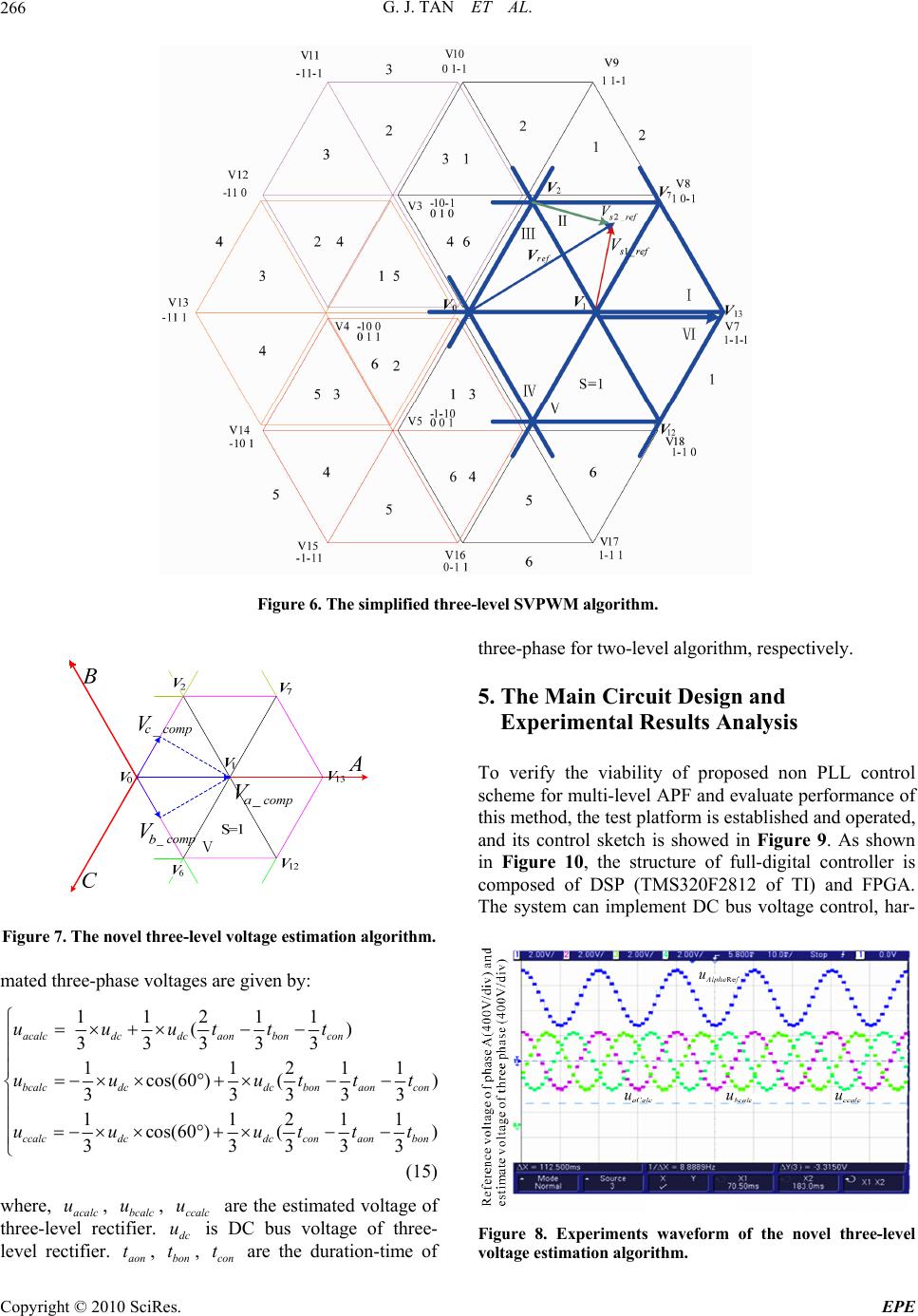 G. J. TAN ET AL. Copyright © 2010 SciRes. EPE 266 Figure 6. The simplified th ree-level S VPWM algorithm. Figure 7. The novel three-level voltage estimation algorithm. mated three-phase voltages are given by: 11211 () acalcdcdc aonboncon uuuttt 33 333 11 ) 33333 11211 cos(60 )() 33333 aon con ccalcdcdc conaonbon tt uu uttt (15) where, are the estimated voltage of DC bus voltage of three- are the duration-time of three-phase for two-level algorithm, respectively. Design and Experimental Results Analysis To verify the viability of proposed non PLL control scheme for multi-level APF and evaluate performance of this method, the test platform is established and operated, and its control sketch is showed in Figure 9. As shown in Figure 10, the structure of full-digital controller is composed of DSP (TMS320F2812 of TI) and FPGA. The system can implement DC bus voltage contro 5. The Main Circuit l, har- 112 cos(60 )( bcalc dcdc bon uu ut acalc u, three-level rectifier. level rectifier. bcalc u, aon t, ccalc u dc u is bon t, tcon Figure 8. Experiments waveform of the novel three-level voltage estimation algorithm. 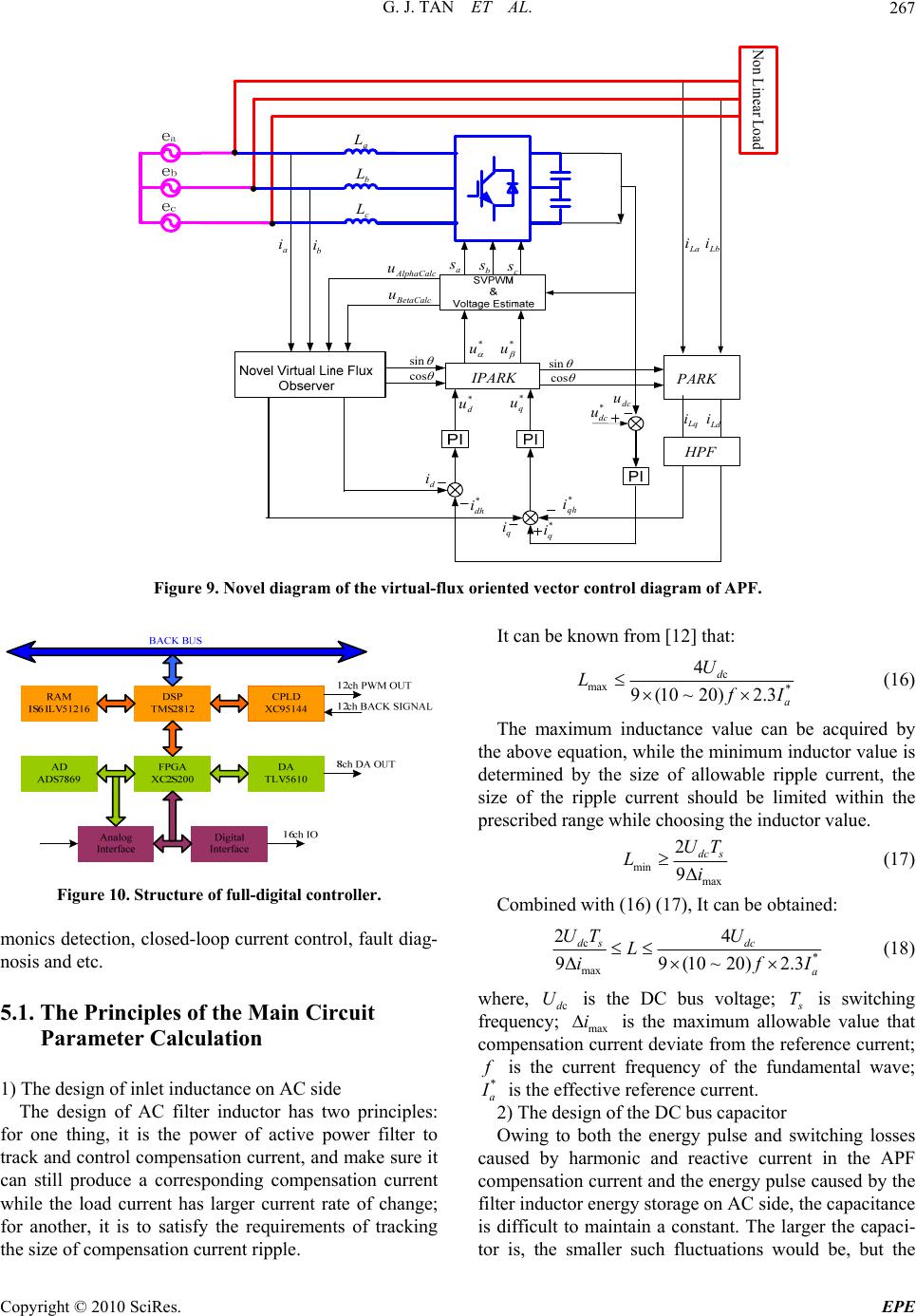 G. J. TAN ET AL.267 * q i * dh i d i q i * dc u a i b i dc u * d u * q u * u * u a s b s c s sin cos sin cos * qh i La i Lb i I PARK P ARK a L b L c L LoadLinear Non Ld i Lq i HP F AlphaCalc u BetaCalc u Figure 9. Novel diagram of the virtual-flux oriented vector control diagram of APF. Figure 10. Structure of full-digital controller. monics detection, close osis and etc. 5.1. The Principles of the Main Circuit Parameter Calculation 1) The design of inlet inductance on AC side The design of AC filter inductor has two principles: for one thing, it is the power of active power filter to track and control compensation current, and make sure it can still produce a corresponding compensation current while the load current has larger current rate of change; for another, it is to satisfy the requirements of trackin the size of compensation current ripple. It can be known from [12] that: d-loop current control, fault diag- n g c max * 4 9(10~20)2.3 d a U LfI (16) The maximum inductance value can be acquired by the above equation, while the minimum inductor value is determined by the size of allowable ripple current, the size of the ripple current should be limited within the prescribed range while choosing the inductor value. min max 2 9dc s UT Li (17) Combined with (16) (1 7), It can be obtained: c 99(10 ~ 20) ds dc L if * max 24 2.3 a UT U I (18) where, cd U is the DC bus voltage; s T is swi cy; max itching equenfr is the maximum allowable value that compensation current deviate from the reference current; f is the current frequency of the fundamental wave; * a I is the effective reference current. osses causecurrent in the APF mpensation current and the energy pulse caused by the apacitance is difficult to maintain a constant. The larger the capaci- tor is, the smaller such fluctuations would be, but the 2) The design of the DC bus capacitor Owing to both the energy pulse and switching l d by harmonic and reactive co filter inductor energy storage on AC side, the c Copyright © 2010 SciRes. EPE 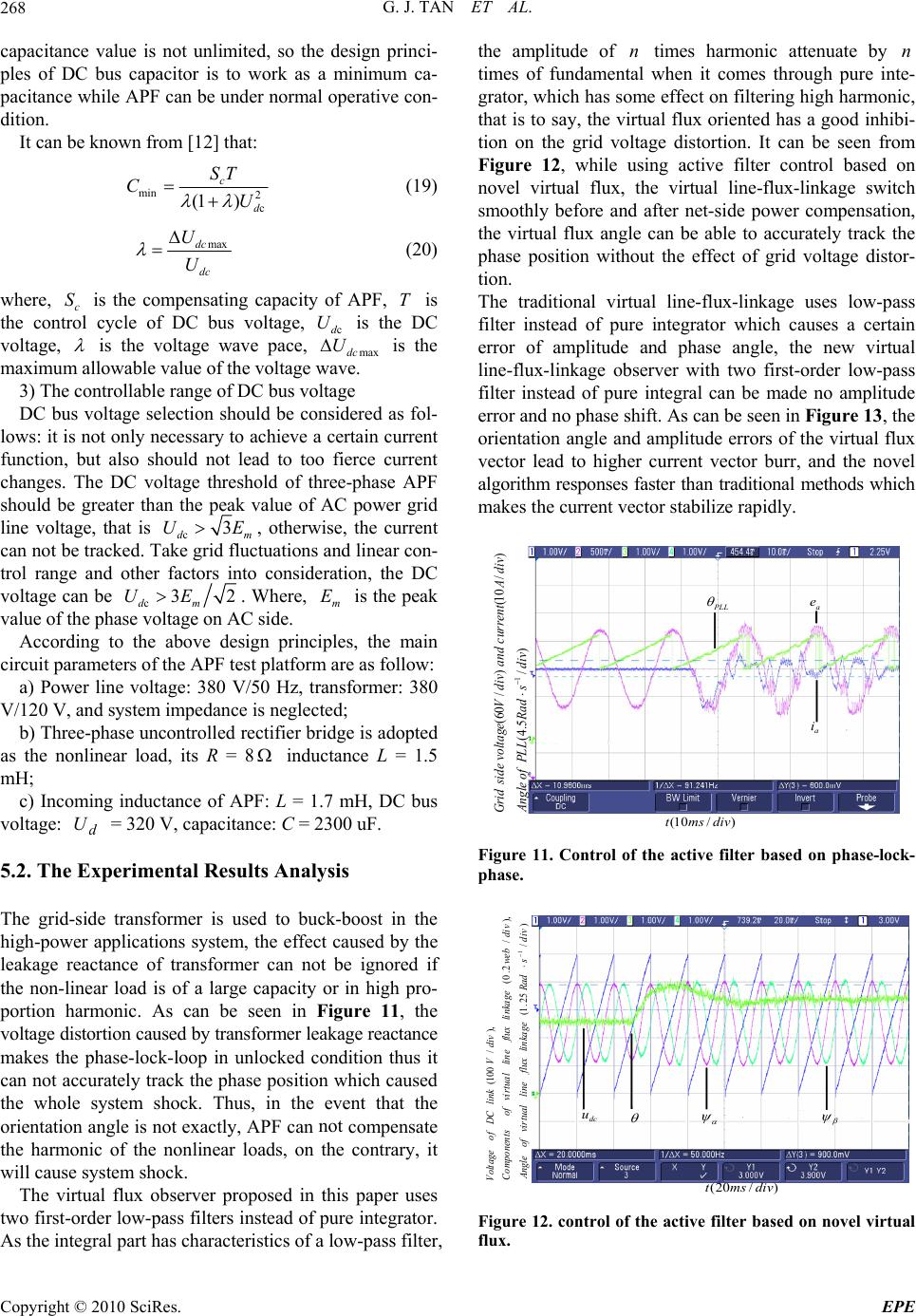 G. J. TAN ET AL. 268 capacitance value is not unlimited, so the design princi- ples of DC bus capacitor is to work as a minimum ca- pacitance while APF can be under normal operative con- dition. It can be known from [12] that: min 2 c ST C (19) c (1) d U maxdc dc U U w (20) here, c S is the compensating capacity of APF, T is the control cycle of DC bus voltage, cd U is the DC voltage, is the voltage wave pace, maxdc U is the maximum allowable value of the voltage wave. 3) The controllable range of DC bus voltage DC bus voltage selection should be considered as fol- lows: it is not only necessary to function, but also should not lead to too fierce current chase APF should be greater than the peak value of AC power grid line voltage, that is achieve a certain current anges. The DC voltage threshold of three-ph c3 dm UE, otherwise, can not be tracked. Take grid fluctuations and linear con- e aer be the current trol rangnd other factors into considation, the DC voltage can c32 dm E. Where, m E is the peak value of the phase voltag e on AC side. According to the above design principles, the main cuit parameters of the APF test platf U cir orm are as follow: ansformer: 380 V d-side transformer is used to buck-boost in the hi e effect caused by the leakage reactance of transformer can the non-linear load is of a large ca portion harmonic. As can be seen in Figure 11, the voltage distortion caused by tra makes the phase-lock-loop in use not n ual flux orie ux, the virtual-lin er compensation, th tio low-pass fil n ux-linkage observer with two first-order low-pass fil no 3, the rientation angle and amplitude errors of the virtual flux the novel gorithm responses faster than traditional methods which a) Power line voltage: 380 V/50 Hz, tr /120 V, and system impedance is neglected; b) Three-phase uncontrolled rectifier bridge is adopted as the nonlinear load, its R = 8 inductance L = 1.5 mH; c) Incoming inductance of APF: L = 1.7 mH, DC bus voltage: d U = 320 V, capacitance: C = 2300 uF. 5.2. The Experimental Results Analysis The gri gh-power applications system, thnot be ignored if pacity or in high pro- nsformer leakage reactance unlocked condition thus it can not accurately track the phase position which cad the whole system shock. Thus, in the event that the orientation angle is not exactly, APF can compensate the harmonic of the nonlinear loads, on the cotrary, it will cause system shock. The virtual flux observer proposed in this paper uses two first-order low-pass filters instead of pure integrator. As the integral part has characteristics of a low-pass filter, the amplitude of n times harmonic attenuate by n times of fundamental when it comes through pure inte- grator, which has some effect on filtering high harmonic, that is to say, the virtnted has a good inhibi- tion on the grid voltage distortion. It can be seen from Figure 12, while using active filter control based on novel virtual fl line-fluxkage switch smoothly before and after net-side pow e virtual flux angle can be able to accurately track the phase position without the effect of grid voltage distor- n. The traditional virtual line-flux-linkage uses ter instead of pure integrator which causes a certain error of amplitude and phase agle, the new virtual line-fl ter instead of pure integral can be made no amplitude error and phase shift. As can be seen in Figure 1 o vector lead to higher current vector burr, and al makes the current vector stabilize rapidly. a i a e PLL )/5.4( )/10()/60( 1 divsRadPL L divAcurrentanddivVvoltageide ofAngle Grid )/10(divmst Figure 11. Control of the active filter based on phase-lock- phase. s dc u )/25.1( ),/2.0( ),/100( 1divsRadlin kagefluxne divweblinkagefluxlinertual divVk livirtua lofAngle viofComponents linDCofVolta ge )/20(divmst Figure 12. control of the active filter based on novel virtual flux. Copyright © 2010 SciRes. EPE  G. J. TAN ET AL.269 (a) (b) Figure 13. The vectorgraph of power current in axes, (a) Using low-pass filter instead of pure integrator; (b) Novel virtual flux observer. Figure 14 shows the harmonic and fundamental wave detected by the load current rotational coordinates detec- tion method virtual line-flux-linkage orientation based. The method realizes harmonic current detection without PLL, and compare with the traditional i p q i by freque detection method PLL based, it is not restrained ncy shift and it can omit the PLL circuit avoiding the effect that out of control of PLL brings to system of the active filter. Moreover, not only the fundamental component of the detecting current becomes more flexible but also the de- tection accuracy of harmonic current is higher. Figure 15 is the final compensated line current. It is easy to found that the curre nearly close to sinusoidal nd the third, fifth, seventh, ninth, eleventh and thirteenth harmonics are filtered off mostly. But there exist high harmonics by selecting the switching fre- quency of 2 kHz, and it is easy to be solved by the method of a high-pass filter (HPF) in parallel with the power system. Figure 16 is the system response in the condition of abrupt change of 50% load more. The system has an ex- cellent dynamic performance that it can be stable after 2-3 periods. According to Figure 16(a), the APF based on virtual flux oriented vector control system uses a voltage outer loop and the DC bus voltage coincide with the given voltage when the system comes to be stable. The voltage amplitude fluctuation is minimal which means that there’s energy exchange just between the DC side of active filter and load while the system arrive at a steady state condition. As can be seen in Figure 16(b) the DC side voltage and noint potential fluctua- nt is a , eutral p tion is minimal, and it shows that the strategy used in this system which is based on DC side voltage and capaci- tance detection and neutral point potential adaptive La i ~ Ld i A/div)C urrent(20 Harmonic and A/div)Current(20 lFundamenta )/10(divmst Figure 14. The harmonics current and the fundamental wave. sa i Analysis FFT (20Current Source )/10(divmst Figure 15. The compensated source current and FFT analy- sis. A/div) Copyright © 2010 SciRes. EPE  G. J. TAN ET AL. Copyright © 2010 SciRes. EPE 270 dc u /div) an sa i (10A Currents Source d div )200V/lin DC of Voltages )/50(divmst (a) k( updc u _ downdc u _ intneutral_po u (50/divint div)0V/ )po ne utr al of Volt age s andli DC of Voltages )/50(divmst (b) Figure 16. The dynamic response of the system, (a) The power system current and DC bus voltage response under abrupt condition; (b) DC bus voltage and neutral point potential response under abrupt c ondition. hese results proved that the novel control algorithm with virtual line-flux-linkage-oriented based control sys- tem possess strong robustness, and also demonstrated that the simplified three-level SVPWM strategy with neutral point potential self-adaptation is valid. 6. Conclusions The experimental results show that the scheme of adopt- ing the proposed virtual line-flux-linkage-oriented ob- server can realize the non-PLL control for APF, and dis- played that the load current detection under rotatin ordinate oriented by virtual line-flux-linkage can n only detects harmonics cut rapidly but also makes e compensating current tracked reference fast, and in- dicated that APF system with the method of discusse flux oriented and rotating coordinate based harmonics detection has the characteristics of decreasing line total harmonic distortion (THD) significantly and superior dynamic property, thus it is obvious that leading the sim- plified three-level SVPWM strategy with neutral point potential self-adaptation in control can improve the sys- tem’s overall performance. 7. References [1] M. EI-Habouk, M. K Darwish and P. Mehta, “Active Power Fliter. A Review,” IEE Proceedings of Electron Power Application, Vol. 147, No. 7, January 2000, pp. 403-414. [2] M. Izhar and C. M. Hr, “Performance for Passive rque Control of ng. “A 31- s,” IEEE Industrial Electrics, Vol. 49, No. 3, June ] L. S. Czarnecki, “On Some Misinterpretation of the In- da “A New Method to Elimate urrents by Magnetic Flux Compensation on Basic Design,” IEEE Transactions on , Vol. PAS-90, No. 5, Septem- adze Filter Inreducing Harmonics in the Distribution System,” Power and Energy Conference, Selangor, November 2004, pp. 104-108. [3] M. Jasinski, D. Swierczynski and M. P. Kazmierkowski, “Novel Sensorless Direct Power and To Space Vector Modulated ac/dc/ac Converter,” IEEE In- ternational Symposium, Vol. 2, May 2004, pp. 1147-1152 . nk(10 [4] Y. Ye, M. Kazerani, V. H. Quintana, “A Novel Modeling and Control Method for Three-Phase PWM Converters,” IEEE 32th Annual, PESC, Vancouver, Vol. 1, June 2001, pp. 102-107. [5] C. K. Lee, S. Y. Ron Hui and H. S.-H. Chu Level Casecade Inverter for Power Application Transactions on 2002, pp. 613-617. [6 stantaneous Reactive Power p-q Theory,” IEEE Transac- tions on PE, Vol. 19, No. 3, May 2004, pp. 828-836. [7] M. Malinowski, M. P. Kazmerkowski, S. Hansen, FBlaabjerg and C. D. Marques,“Virtual-Flux-Based Di- rect Power Control of Three-phase PWM Rectifiers,” IEEE Transactions on Industry Applications, Vol. 37, No. 4, August 2001, pp. 1019-1027. [8] H. Sasaki and T. Machida “A New Method to Elimate AC Harmonic Currents by Magnetic Flux Compensation Considerations on Basic Design,” IEEE Transactions on Power Application System, Vol. 90, No. 5, 1971, pp. 2009-2019 [9] R. D. Zhao and Y. K. He, “Simulation Study on the Vir- tual Line Flux Oriented Vector Control of the PWM Rec- tifier,” Proceedings of the CSU 2EPSA, Vol. 17, No. 5, October 2005, pp. 94-98. 10] H. Sasaki and T. Machi compensation can effectively control the neutral-poin potential both in static and dynamic operating conditions. T t [ g co- o ber 1971, pp. 2009-2019. [11] J. H. Seo, C. H. Choi and D. S. Hyun, “A New Simplified Space-Vector PWM Method for Three-Level Inverter,” IEEE Transactions on Power Electronics, Vol. 16, No. 4, AC Harmonic C Considerations Power Application System t rren th d July 2001, pp. 545-550. [12] E. Teresa and J. A. Pomilio, “Shunt Active Power Filter Synthesizing Resistive Load,” IEEE transactions on Power Electron, Vol. 17, No. 2, March 2002, pp. 273-278. |

